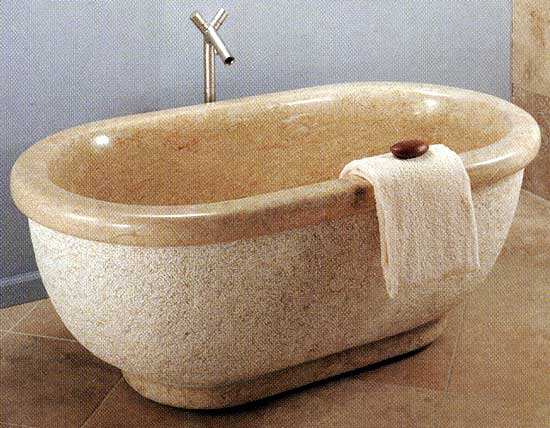Understanding Stone Bathtub Materials: Natural vs. Engineered
Natural Stone Options: Granite, Marble, and Travertine
Granite Marble & Travertine Natural stones such as granite, marble, and travertine all have distinct properties which determine their suitability for bathtubs. Granite, celebrated for its remarkable longevity and scratch resistance, is a smart choice for longevity seekers. On the other hand, marble is known for its luxurious appearance but is porous and requires regular sealing. Travertine in warm and earthy tones is not so frequently used in wet areas, but provides a unique and timeless ambiance in a bathroom. When choosing natural stone, sourcing is everything; going local for your stone suppliers can have an effect on cost and environmentalism. Take granite, for example, which is often sourced from nearby and may be a more affordable as well as an environmentally friendly choice than imports.
Benefits of Engineered Stone for Bathrooms
Engineered stone is a contemporary alternative for your bathroom, combining beauty and function. Engineered stones, composed completely of crushed stone bound together by resins, have replicated the look of natural stone and provide a much more consistent color and pattern. This composition leaves engineered stone much less porous, less likely to stain and very low maintenance. Plus, the design variety with engineered stones allows for creativity, with shapes and sizes to suit contemporary bathroom installations. This versatility has made engineered stone a common option for homeowners and interior decorators, providing the look without the maintenance hassle.
Comparing Weight and Cost Across Materials
For example, the weight of stone bathtubs is a significant consideration, as it differs drastically for natural versus engineered stone products. Natural stone options (ex: granite) are heavier than man-made options, and may require more structural reinforcement to withstand the weight. This may affect installation logistics and expenses. Cost is also a critical consideration; natural stone like marble and travertine is typically more expensive due to extraction, transit and upkeep expenses. Engineered stone is significantly more affordable and a great alternative without forfeiting the beauty, durability, and fit. One of the reasons for this is engineered alternatives are a popular option for people on a budget who want luxurious looks for their bathroom.
Design Considerations: Shape, Size, and Bathroom Layout
Popular Shapes: Rectangular, Oval, and Freestanding Styles
The shape you select for your stone tub is crucial so you can attain your desired look in your bathroom. Rectangular bathtubs are a great way to complete your modern bathroom as they are sleek, urbane and strong in design, whilst a freestanding bath will make an elegant, statement in a traditional bathroom. Oval shaped hot tubs, on the other hand, are usually the preferred ones as these tend to have the most beautiful curves which can provide a touch of class. They provide a comfortable bathing experience and a peaceful, simple design for a home-spa. Freestanding types distinguish themselves by providing placement options that sometimes result in more imaginative bathroom designs. Freestanding tubs can change the flow of the room or the décor, whether they’re tucked under a big window or centered in the space.
Matching Bathtub Size to Bathroom Dimensions
High Quality Fitting a stone bath in your bathroom When fitting a stone bath into your bathroom size is everything. It is also best to accurately measure your bathroom size first; you don’t want a soaking tub that just fits in the space. As a general guideline, try to keep at least 3 inches around the tub for access and use. In case of smaller bathrooms, try using corner bathtubs or compact designs that help reduce the area that bath occupies, and use them accordingly. They're designed to save space on your floor while still giving you the same kind of luxurious bathing experience. In the end, it is all about choosing a convenient bath size that suits your bathroom floor plan and the usage you will be putting the tub through.
Coordinating with Wall Tiles and Countertops
How good the stone bath matches the wall tiles, the countertops. is mainly related to the general appearance of your bathroom. Materials and colors of the bathtub should be coordinated with the surrounding in order to have a coherent design. For example, how about having black granite kitchen countertops that contrast with smoother, lighter stone on your bathtubs as an aesthetic enhancement? Conversely, if you match tones between surfaces you can achieve a harmonious and calming environment. Because wall tiles for bathrooms are available in an array of styles, from traditional to modern, choosing a pattern that complements your tub design and blends with the rest of the room is easy to find.
Built-In vs. Freestanding Installation Styles
Space Requirements for Different Installations
When it comes to built-in vs stand alone bathtubs, the decision is based in large part on how much space you … With built-in bathtubs, there’s a little more of a need for structure and more careful plumbing considerations, possibly limiting their use to certain places in a bathroom. Freestanding ones, on the other hand, tend to be more versatile and fit whatever room layout is required. This versatility enables freestanding bathtubs to be fit for almost any bathroom plan, so it happend to be a preferencial option for anyone in need of personalizing their space. In the end, a complete review of the bathroom's space accessibility should be conducted to determine which type of installation can both fit the space and allow an entryway that is inviting and appealing.
Structural Support for Heavy Stone Materials
Heavy stone bathtubs (such as granite or marble) need strong, secure support to avoid floor issues down the road. It is recommended that before installing, all owners should seek the advice of a contractor or expert as natural stone products are very dense and heavy. Errors in the determination of the necessary support can cause the major difficulties, which again proves the necessity of an accurate analysis. It is important to know the weaknesses and strengths of your bathroom's space to ensure for a successful installation and to make planning as efficient as possible.
Aesthetic Impact on Bathroom Design
Welcome etoup010, The installation of the bath is paramount in determining the look of the bathroom. Freestanding bathtubs are typically the centerpieces of a bathroom as they stand alone, catching the eye and offering an air of sophistication. Conversely, built-in tubs look as though they have emerged from the cabinetry, which lends itself to a cohesive, unified design. Modern bathroom design takes on steam with free-standing tubs Soaking away the day’s grit has found new fans in a generation of home buyers who are craving expansive spa-like bathrooms with the latest features. This is in keeping with the demand for flexible and fashionable bathrooms that can be tailored to individual preference and practical requirements.
Evaluating Durability and Maintenance Needs
Porosity and Sealing Requirements
Permeability has a very important role in the preservation of stone bathtubs. Natural stones such as marble and travertine are more porous, so they’ll need to be sealed more often to avoid water seepage and staining. This is important because if the sealant is not such it can eventually damage the join down the line and then you are up for expensive repairs or replacements. These two have more porosity compare to the engineered stones which makes them relatively a bit harder to clean as the time progresses. So you need to know if your chosen material have sealing needs in order to increase its lifespan and avoid future problems.
Heat Retention and Surface Care
One of the other reasons behind why people like stone bathtubs is that they are pretty good at holding the heat. For instance granite is known for keeping water hot for longer, which makes for a better bathing experience. But what is the best way to treat the surfaces? Man made stones tend to offer easier cleaning options, whereas stones such as natural marble might have to have specific, gentle cleaning products to not damage the surface. Understanding these surface care needs is essential to sustaining the bath's beauty and functionality through the years.
Long-Term Wear Resistance
One of the most important things when considering your stone bathtubs is of course how long they will last. Artificial stones are frequently scratch- and stain-resistant - a huge plus when it comes to retaining an ‘as new’ look. However, with some tender, loving care, natural stones can endure for many years, which allows them to become an investment that will overwhelm you from the bathroom to the grave. The longevity appeal emphasizes the need for ongoing care and adherence to maintenance schedules needed to extend the life of the bathtub.
Selecting a Reputable Stone Supplier
Verifying Stone Quality and Authenticity
Quality and genuine stones are of utmost importance when it comes to choosing a stone supplier. One pragmatic way is to ask for the samples that illustrate the real properties of the material. For instance, stone samples can provide insight into porosity, colour consistency and surface texture - all factors that are important for projects such as black granite kitchen countertops or bathroom wall tiles. Also looking for certain unsigned or unmarked stones for specific lab markings or certifications increases assurance that the stones are responsibly and ethically sourced. Most certifications will show that the stone supply has been checked to see if it conforms to professional standards and, therefore, is high quality.
Supplier Certifications for Granite and Quartz
Reliable dealers are certified suppliers of granite and quartz products, and these certifications can ensure their materials are of the highest standards. These certifications are usually issued by industry groups that are committed to ensuring the highest levels of professionalism in the stone supply sector. For the customer, this is peace of mind that the product you are buying has been tested, it is good quality and will last and is suitable for environments that require heavy duty features at home such as the black granite kitchen countertops. Certifications allow consumers to make educated decisions, preventing them from purchasing subpar products that would force them into costly replacements and repairs.
Balancing Cost with Material Integrity
It's important to be budget-conscious, of course, but the least expensive stone may not wear as well. A good balance between cost and the integrity of the material is important to prevent replacing it in the near future. When doing homework and seeking multiple stone suppliers’ price quotes, you are able to choose a supplier who offers competitive price but still maintains good quality. That way, you can be guaranteed of long-term satisfaction and value, because the better quality of stones you use, the less maintenance they typically demand over time, saving you money and effort in the long run. Choosing an established stone supplier guarantees that the quality of materials used is durable, thereby keeping up to its appearance and structure against all types of elements.

